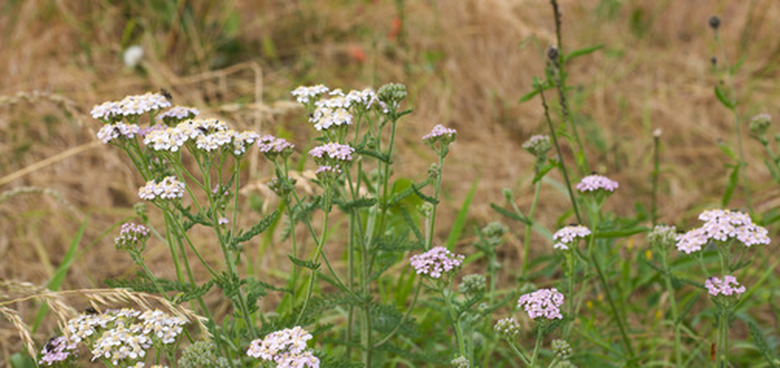Planting Wild Flowers In Tennessee
Things Needed
- Hand trowel
- Shovel
- Garden rake
- Soil test kit
A planting of wildflowers not only adds beauty to any area but is also virtually maintenance-free once established. Though many of Tennessee's unique wildflowers are endangered and very difficult to find, wildflowers suited for North Carolina, Georgia and Alabama typically also perform well in most areas of Tennessee. Plan to take up to a year for site selection, planning and planting; careful preparation will reward the meticulous gardener with lush meadows of wildflowers for years to come.
Site Selection and Evaluation
Step 1
Survey the property for potential wildflower growing areas. The best sites are located in full sun with recently disturbed soils or low-growing grasses.
Step 2
Assess the site to try to determine how it drains. Wildflowers tend to grow best in well-drained sites where water will not collect or stand for too long, though there are types of bog wildflowers that do prefer soggy conditions.
- A planting of wildflowers not only adds beauty to any area but is also virtually maintenance-free once established.
Step 3
Determine the soil type, as this will largely determine the types of wildflowers to be planted. Soils that are primarily comprised of clay will be sticky and poorly draining when wet, yet very hard when dry. Loamy soils are crumbly and darker in color due to a higher content of organic matter like rotted vegetation. Sandy soils are just that–primarily comprised of sand.
Step 4
Follow the directions that are included with the soil test kit to take a soil sample. Labs test these soil samples to determine its nutrient content and acidity, which will dictate how much, if any, fertilizer or soil amendments will be required to improve or adjust your site's soil.
Wildflower Plant Selection
Step 1
Research suppliers of young wildflower starts in your area.
- Determine the soil type, as this will largely determine the types of wildflowers to be planted.
- Loamy soils are crumbly and darker in color due to a higher content of organic matter like rotted vegetation.
Step 2
Describe your site and soil conditions to a perennial plant expert at the nursery. He will be able to recommend certain plants that tend to perform well under your conditions or recommend a wildflower seed mix.
Step 3
Ask about special care any of the plants will need in order to get them established. Some plants are very low-maintenance from the start, though some plants may need additional watering or fertilizing in the first several months to get them through the trauma of transplanting.
Arrangement and Planting
Step 1
Study the plant tags that come with each plant you've selected for your wildflower meadow.
Step 2
Arrange plants loosely around your site by height. The shortest plants should be placed in the front of the planting area, followed by mid-height and finally by the tallest plants in the rear.
- Describe your site and soil conditions to a perennial plant expert at the nursery.
- He will be able to recommend certain plants that tend to perform well under your conditions or recommend a wildflower seed mix.
Step 3
Take a few steps back and try to visualize how an established planting will look. Keep flower color and height in mind as you do this; group plants by similar color for a more formal effect, or mix plants randomly for a more naturalized look.
Step 4
Finalize the planting arrangement by ensuring plants are spaced at a proper distance from each other. In addition to height and flower color information, plant tags also list recommended spacing information. A spacing of 12 inches is from the plant's center, not its edge.
Step 5
Choose a warm, overcast day in spring or autumn to plant. Roots of plants exposed to strong sunlight or high winds dry out quickly and subject the plant to undue stress.
- Take a few steps back and try to visualize how an established planting will look.
- Keep flower color and height in mind as you do this; group plants by similar color for a more formal effect, or mix plants randomly for a more naturalized look.
Care and Culture
Step 1
Water newly planted wildflower plants generously and frequently, especially during the hot Tennessee summer months. New plantings should receive at least an inch of water each week. Once established, plants typically will survive from rainfall to rainfall without much stress.
Step 2
Be judicious in your use of nitrogen-based fertilizers. Many wildflowers prefer poorer soils, and too much nitrogen fertilizer will encourage foliar growth but few blooms. Excess fertilizer also stimulates the growth of weeds, which can crowd out young wildflower plants if allowed to run rampant.
Step 3
Avoid cutting back above-ground portions of new plantings when they go dormant in the winter. Not only do the dead stems help protect the roots during the coldest months, but mark where plants will reappear in the spring.
- Water newly planted wildflower plants generously and frequently, especially during the hot Tennessee summer months.
- Many wildflowers prefer poorer soils, and too much nitrogen fertilizer will encourage foliar growth but few blooms.
Tip
If you wish to start a wildflower planting from seed, many nurseries offer customized seed mixes suited to particular conditions (boggy, dry, shady). The benefit to seed mixes is that the end result is much more meadowlike and natural. However, sites where seed is to be planted should be fairly free from weeds and other plants, which requires more in the way of shoveling and raking than a planting of potted plants.
Warning
Be sure to research or ask where your nursery gets its plant stock. Be sure your source nursery either propagates its own plants or buys them from a wholesale propagator, especially in the case of rare or endangered wildflowers–illegal collection of wildflower plants is a main contributor to their decline in the wild.
